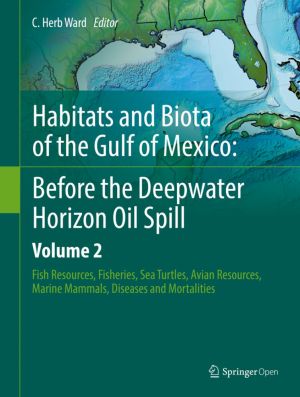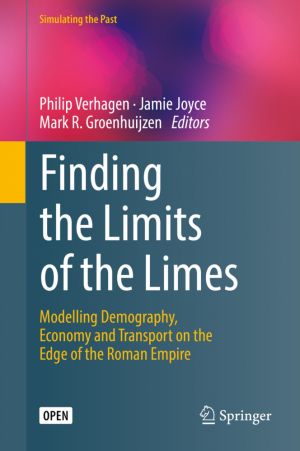Habitats and Biota of the Gulf of Mexico: Before the Deepwater Horizon Oil Spill
Volume 1: Water Quality, Sediments, Sediment Contaminants, Oil and Gas Seeps, Coastal Habitats, Offshore Plankton and Benthos, and Shellfish
by C. Herb Ward
DescriptionDetailsHashtagsReport an issue
Volume 1 covers:
• Water and sediment quality and contaminants, to provide perspective on environmental conditions in the Gulf.
• Natural oil and gas seeps in the Gulf of Mexico, to identify natural sources of exposure to petroleum hydrocarbons.
• Coastal habitats, including flora and fauna and coastal geology.
• Offshore benthos and plankton, with an analysis of current knowledge on energy capture and energy flows in the Gulf.
• Shellfish and finfish resources that provide the basis for commercial and recreational fisheries.Volume 2 covers:
• Historical data on commercial and recreational fisheries, with an analysis of marketing trends and drivers.
• Ecology, populations and risks to birds, sea turtles and marine mammals in the Gulf of Mexico.
• A final chapter extensively illustrated with original images on diseases and mortalities of fish and other animals that inhabit the Gulf of Mexico.
Chapters in these volumes have been peer reviewed by scientific experts in the subject areas covered. Hopefully, the collection and analysis of such data for the Gulf of Mexico will be continued and sponsored by responsible federal and state agencies with the frequency needed to accurately assess potential damage to natural resources from ecologically harmful events that may occur in the future. 






Book Description
The Gulf of Mexico is an open and dynamic marine ecosystem rich in natural resources but heavily impacted by human activities, including agricultural, industrial, commercial and coastal development. Nutrients and pollutants from coastal communities and dozens of rivers flow into the Gulf, including material from the Mississippi River watershed, which drains over one third of continental United States. The Gulf of Mexico has been continuously exposed to petroleum hydrocarbons for millions of years from natural oil and gas seeps on the sea floor, and more recently from oil drilling and production activities located in the water near and far from shore. Major accidental oil spills in the Gulf are infrequent; two of the most significant include the Ixtoc I blowout in the Bay of Campeche in 1979 and the Deepwater Horizon Oil Spill in 2010. Unfortunately, baseline assessments of the status of habitats and biota in the Gulf of Mexico before these spills either were not available, or the data had not been systematically compiled in a way that would help scientists assess the potential short-term and long-term effects of such events.This 2-volume series compiles and summarizes thousands of data sets showing the status of habitats and biota in the Gulf of Mexico before the Deepwater Horizon Oil Spill that began on April 20, 2010. Volume 1 begins with an overview of the following 13 chapters and focuses on the big picture rather than the details of habitat quality and biota.Volume 1 covers:
• Water and sediment quality and contaminants, to provide perspective on environmental conditions in the Gulf.
• Natural oil and gas seeps in the Gulf of Mexico, to identify natural sources of exposure to petroleum hydrocarbons.
• Coastal habitats, including flora and fauna and coastal geology.
• Offshore benthos and plankton, with an analysis of current knowledge on energy capture and energy flows in the Gulf.
• Shellfish and finfish resources that provide the basis for commercial and recreational fisheries.Volume 2 covers:
• Historical data on commercial and recreational fisheries, with an analysis of marketing trends and drivers.
• Ecology, populations and risks to birds, sea turtles and marine mammals in the Gulf of Mexico.
• A final chapter extensively illustrated with original images on diseases and mortalities of fish and other animals that inhabit the Gulf of Mexico.
Chapters in these volumes have been peer reviewed by scientific experts in the subject areas covered. Hopefully, the collection and analysis of such data for the Gulf of Mexico will be continued and sponsored by responsible federal and state agencies with the frequency needed to accurately assess potential damage to natural resources from ecologically harmful events that may occur in the future.
This open book is licensed under a Creative Commons License (CC BY-NC). You can download Habitats and Biota of the Gulf of Mexico: Before the Deepwater Horizon Oil Spill ebook for free in PDF format (65.0 MB).
Book Details
Title
Habitats and Biota of the Gulf of Mexico: Before the Deepwater Horizon Oil Spill
Publisher
Springer
Published
2017
Pages
917
Edition
1
Language
English
ISBN13
9781493934454
ISBN10
1493934457
ISBN13 Digital
9781493934478
ISBN10 Digital
1493934473
PDF Size
65.0 MB
License

Related Books

The Gulf of Mexico is an open and dynamic marine ecosystem rich in natural resources but heavily impacted by human activities, including agricultural, industrial, commercial and coastal development. Nutrients and pollutants from coastal communities and dozens of rivers flow into the Gulf, including material from the Mississippi River watershed, whi...

Books about Oxford have generally focused on the University rather than the city. This original book on the local politics of Oxford City from 1830 to 1980 is based on a comprehensive analysis of primary sources and tells the story of the city's progressive politics. The book traces this history from Chartism and electoral reform in the mid-ni...

This book examines key aspects of international cooperation to enhance nuclear safety, security, safeguards, and non-proliferation, thereby assisting in development and maintenance of the verification regime and fostering progress toward a nuclear weapon-free world. The book opens by addressing important political, institutional, and legal dimensio...

David Harvey's The Condition of Postmodernity rationalised capitalism's transformation during an extraordinary year: 1989. It gave theoretical expression to a material and cultural reality that was just then getting properly started - globalisation and postmodernity - whilst highlighting the geo-spatial limits to accumulation imposed by o...

This book demonstrates the application of simulation modelling and network analysis techniques in the field of Roman studies. It summarizes and discusses the results of a 5-year research project carried out by the editors that aimed to apply spatial dynamical modelling to reconstruct and understand the socio-economic development of the Dutch part o...

This open access book, inspired by the ICME 13 Thematic Afternoon on "European Didactic Traditions", consists of 17 chapters, in which educators from the Netherlands reflect on the teaching and learning of mathematics in their country and the role of the Dutch domain-specific instruction theory of Realistic Mathematics Education.Written b...

